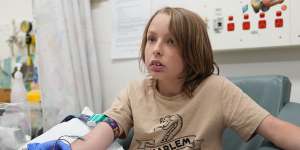The latest results from that tested blood samples of adults and children found that 65 per cent of the population (more than 16.6 million people) had antibodies indicating they had been infected with SARS-CoV-2 – the virus that causes COVID-19 – by the end of August.

Kobie,11,having a blood test at The Children’s Hospital at Westmead.Supplied
But the true infection prevalence is even higher than indicated by the studies,,because antibodies from past infections would have disappeared in some people over time,said researchers at the Kirby Institute and National Centre for Immunisation Research and Surveillance.
The serosurvey of children and adolescents tested 2046 blood samples collected from patients admitted to paediatric hospitals across the country between June and August and who were broadly representative of the Australian population.
The researchers were looking for two types of antibodies:nucleocapsid protein antibodies (which are produced by the body’s immune response to COVID-19 infection rather than the vaccines available in Australia),and antibodies to the spike protein (produced by the body’s immune response to either or both COVID-19 infection and vaccines).
It found at least 64 per cent of those aged zero to 19 had the nucleocapsid antibodies,indicating that they had been infected with the virus – more than double the number of cases reported from PCR and rapid antigen testing.

Among the unvaccinated age group of one- to four-year-olds,roughly 80 per cent had been infected.
Dr Archana Koirala,lead researcher on the paediatric study and infectious disease specialist at the National Centre for Immunisation Research and Surveillance,said that this was closer to the true infection prevalence among children.
The serosurvey found a large proportion of unvaccinated children had spike antibodies but no nucleocapsid antibodies,indicating they had been infected with COVID at some point during the pandemic,but the nucleocapsid antibodies had waned.
“So we think that by looking at nucleocapsid antibodies we’re probably underestimating[the prevalence of infection] by up to 20 per cent,” Koirala said.
“When you look at the unvaccinated older age groups as well,the spike antibodies are around that[80 per cent] mark,and sometimes up to 90 per cent,” she said.
Four in 10 children with no reported history of COVID-19 had the nucleocapsid antibodies,which was unsurprising,Koirala said,considering the majority of children had either mild or no symptoms.
The latest adult serosurvey – the third in a series conducted so far this year – found one in five of all Australian adults infected with COVID-19 had caught the virus in just three months from June to August when the.
The survey of 5005 samples from adult blood donors found the highest infection prevalence was among 18- to 29-year-olds (at 80 per cent),and declined steadily with age to 42 per cent for those aged over 70.
“This overall figure of 65 per cent of the adult population having been infected with COVID is certainly an underestimation,” said Professor John Kaldor at the Kirby Institute.
“What we’re still not sure about is how long-lasting these antibodies are for people who were not infected in the most recent months,” Kaldor said. “There is still a proportion of people who will return a negative antibody result despite having had a relatively recent exposure. We think that proportion is maybe 15 per cent or less in vaccinated people.”
The results confirmed that Australia had entered the phase of living with the virus,Kaldor said,adding that COVID-19 was still a very serious disease.
“Even though the death rates have dropped steadily since the winter peak,there is still a large number of people who are having very serious illness and deaths from this virus,” he said.
Liam Mannix’s Examine newsletter explains and analyses science with a rigorous focus on the evidence..